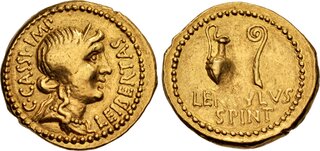| Classical Numismatic Group > Triton XXVII | Auction date: 9 January 2024 |
| Lot number: 620 Price realized: 16,500 USD (Approx. 15,112 EUR) Note: Prices do not include buyer's fees. | Show similar lots on CoinArchives Find similar lots in upcoming auctions on |
| Lot description: The Republicans. C. Cassius Longinus. Spring 42 BC. AV Aureus (21mm, 7.95 g, 6h). Military mint, probably at Smyrna; P. Cornelius Lentulus Spinther, legatus. Diademed head of Libertas right; C • CASSI • IMP upward to left, LEIBERTAS upward to right / Capis and lituus; LENTVLVS/SPINT in two lines below. Crawford 500/2; CRI 220; Sydenham 1306; Bahrfeldt 58; Calicó 65b; Biaggi 45; BMCRR East 76; Kestner 3766; RBW –. Small scratches on reverse, areas of slight weakness. VF. Struck on a broad flan. Very rare. Ex Chaponnière & Firmenich 13 (16 May 2021), lot 251; Vinchon (23 April 1976), lot 210; Münzen & Medaillen AG 43 (12 November 1970), lot 237. Shakespeare depicts the "lean and hungry" Cassius as primary ringleader in the conspiracy against Julius Caesar, motivated more by envy than love of liberty. The Bard gets the basic facts right, but omits the details of Cassius' colorful career. Born into a senatorial family but lacking any talent for politics, Gaius Cassius Longinus found soldiering more to his liking and joined the triumvir Crassus on his doomed expedition against the Parthians in 53 BC. Cassius managed to rescue himself and a handful of others from the massacre and escaped to Roman Syria, where he remained for another two years ably defending the province from Parthian attack. He returned to Rome as a war hero in 51 BC and fell in with the Pompeian faction, serving as commander of Pompey's fleet during the civil war of 49-48 BC. After Pompey's defeat and death, Cassius accepted a pardon from Caesar and loyally served him for the next four years. Cassius perhaps hoped to attain supreme power once Caesar retired, but it soon became apparent the dictator had no intention of stepping down. Thus, Cassius suborned his close friend Marcus Junius Brutus and several other senators into a conspiracy, and he was one of the first to plunge his dagger into Caesar on the Ides of March, 44 BC. After fleeing Rome with the other conspirators, Cassius returned to Syria and commandeered several crack legions and a fleet, which he used to attack and pillage the wealthy island of Rhodes in order to procure gold for the approaching civil war. He joined forces with Brutus in 42 BC and the two marched into Thrace to meet the pro-Caesarian legions led by Mark Antony and Octavian. Though their army outnumbered the Caesarians, Cassius and Brutus seemed oddly fatalistic and made a suicide pact should either meet defeat or capture. At the first clash at Philippi in early October, Cassius suffered a reverse and rashly fell on his sword before he could be told that Brutus had counterattacked and saved the day. Demoralized by his friend's death, Brutus was easily defeated three weeks later and took his own life. This aureus was issued by P. Cornelius Lentulus Spinther and M. Servilius, who were joint legates to Cassius and Brutus and issued coins in the names of their generals. Lentulus Spinther was born in 74 BC and assumed the toga virilis in 57 BC, and in the same year was elected to the college of augurs. After the murder of Caesar, he joined the parties of Cassius and Brutus and was probably killed at Philippi. The reverse type of this coin refers to Lentulus' appointment to the college of augurs, and is one of the few instances in imperatorial coinage in which a moneyer used a reverse type that was personal to himself. Estimate: 10000 USD |  |



